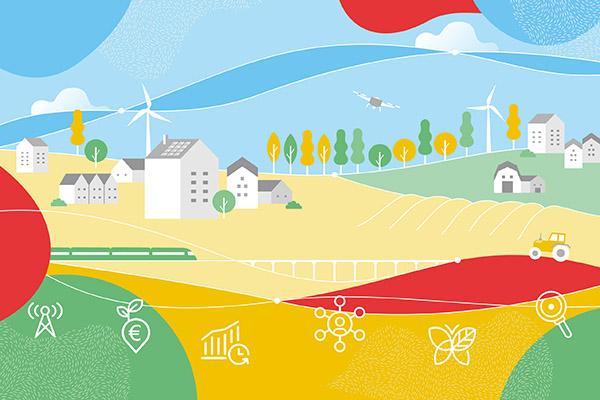We need new and more specific rural data to better understand rural diversity, provide evidence for policy making on rural areas, implement rural proofing, evaluate the impact of EU legislative initiatives and track progress towards the shared goals.
The new rural observatory, improved rural statistics and a definition of functional rural areas contribute to this need.
The rural observatory

The rural observatory aims at centralising and analysing data, ensuring a bridge between data sources through a rural data portal, informing on relevant EU initiatives for rural areas and analysing the achievements of the EU Rural Action Plan. The rural observatory supports knowledge production and aims at disseminating data related to EU rural areas. It offers relevant statistics, indicators and analyses based on data from multiple sources and at the most appropriate territorial level, covering economic, social and environmental dimensions.
Three main tools available:
- “Rural focus”, displays how rural areas compare to cities;
- “My place”, which provides a 360 degrees overview of Member States, regions, sub-regions and municipalities;
- “Trends”, which offers a map showing the evolution of a specific indicator over time.
Improving rural statistics
The Commission works to reinforce statistical data collection and provision in rural areas. It has published on 17 January 2023 a new “Statistics explained” chapter on rural Europe.
New detailed data from the 2021 round of population and housing censuses
EU Member States are currently implementing the 2021 population and housing censuses. These censuses provide very a valuable source of information on the size, demographic structure, education, employment, citizenship, migration characteristics and housing of the population, households and families. The data is at local administrative unit level, and allow to publish new information on rural areas that is not available within annual demographic statistics.
The 2021 round of population and housing censuses will provide by mid-2023 detailed regional information, including a collection of georeferenced population data at 1 km square grid from all Member States.
Find more about population & housing census.
Increasing the availability and quality of official statistics on rural areas
The Commission has adopted on 20 January its proposal for a new framework regulation on European statistics on population and housing which integrates census, demography and migration statistics. The proposal includes effective provisions to enable improved statistics of demography and migration in rural areas, including riche annual and muti-annual statistics.
The Commission is also discussing the proposal and preparing the implementation.
Developing pan-European geospatial datasets
The European Commission works to establish a harmonised approach to the use of Geospatial Information Systems, developing pan-European geospatial datasets. The Commission:
- has published experimental geocoded datasets on health care services and education facilities, as a pilot exercise to explore accessibility analysis to core services that are needed every day.
- is working on a more complete geospatial core data sets infrastructure including administrative units, addresses, buildings, parcels, transport networks and population distribution.
- is working to improve the geospatial definition of the LAUs and NUTS based on the upcoming CENSUS 2021 results.
Mainstreaming the degree of urbanisation
The Commission works to increase the number of indicators that are available by “degree of urbanisation”, which is the typology providing the finest differentiation between urban, semi-dense and rural areas. Over 200 indicators are now available.
Functional Rural Areas
The commission has developed a draft methodology of functional rural areas to make it easier to compare data between countries with very different municipality sizes and will enable new types of analysis, in particular on access to services.
The paper “Developing a definition of Functional Rural Areas in the EU” was published on 23 November 2023. The result of this methodology can be visualised: FRAs Demo (Experimental).
The Commission will continue working and further refining the methodology, in dialogue with partners, such as national statistical offices, scientists working on functional geographies (e.g.: GRANULAR and RUSTIK), the World Bank and the OECD. An OECD project on functional rural areas financed by the Commission has started in the second half of 2023. It will test the value of the approach for non-EU OECD countries.
Rural research projects
Two Horizon Europe funded projects will work on improving rural data and evidence:
GRANULAR - Giving Rural Actors Novel data and re-Useable tools to Lead public Action in Rural areas
GRANULAR will generate:
- new insights to characterise rural diversity using multi-actor and interdisciplinary approaches;
- novel datasets based on insights from multi-actor labs and using a wide range of methods and primary data, such as remote sensing, crowd-sourced data, mobile phone data and web-scraping;
- indicators relevant to rural communities for the implementation of the rural vision, using these novel data sets and existing institutional data.
RUSTIK - Rural Sustainability Transitions through Integration of Knowledge for improved policy processes
RUSTIK aims to provide:
- a robust methodological framework for functional rural areas
- databases integrating data of different types and sources
- improved strategies and governance approaches for rural decision makers and stakeholders
- improved approaches for rural impact assessment and decentralised rural proofing.
ESPON
The European spatial planning observatory network (ESPON) funds research projects and targeted analysis dedicated to territorial analysis. It has a specific stream of work on rural development.
Resources
Our "Resources" section has been moved to the Rural Pact Community Platform and keeps being complemented with new resources. Check it out!
